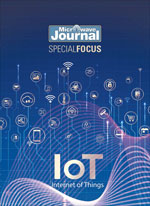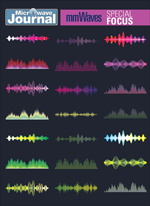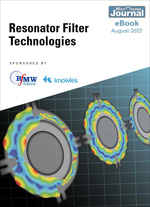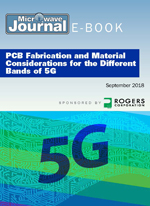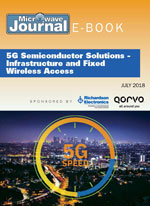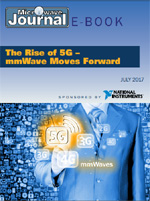Please note:
By downloading an eBook, the details of your profile will be shared with the sponsoring company and you may be contacted by them directly.
IoT Special Focus
This IoT Special Focus eBook covers wireless power transfer and technology outlook, new AWGs and digitizers, a new dual band patch antenna design and new products from various companies.
mmWave Technology Special Focus
The August issue of Microwave Journal includes a special focus section eBook on mmWave technology. The articles cover extreme mobile broadband and wireless fiber plus design of an alumina D-band waveguide to coplanar transition. The eBook also has product articles on a new signal generator, real-time spectrum analyzer and mmWave horn antennas for T&M plus a new products section.
5G/6G Special Focus
This eBook is part of the May 2024 issue as a special focus section on 5G/6G topics including AI in 6G, Interconnection Development for mmWave Applications, and Terabit Wireless plus product information on new DDS AWGs, MMIC filters and low phase noise oscillators. These articles are contributed from industry leading companies such as Keysight, NI, Pasternack, ETI, Marki Microwave, Quantic Wenzel and Spectrum Instrumentation. There is also a new products section.
Innovating on 6G with Artificial Intelligence
Today, the 6G standard is in the early phases. Candidate technologies are being researched, prototyped, and simulated to drive the direction of the 3GPP standards development activity. Applying digital twin workflows to simulations and pairing them with a prototype as it moves through the design phase opens up innovative ways to design and identify optimizations early. Modeling software tools that leverage as much real-world data as possible have the potential to solve significant challenges early by incorporating known insights from existing 5G deployments. Research testbeds will be critical to success if 6G aims to spur collaboration alongside innovation. The ability to prototype new AI, digital twin, and software-defined tools across the wireless ecosystem will provide significant results for applying those technologies wisely. This eBook looks at the design densification and test challenges from migrating 5G communications into the 6G sub-Terahertz frequency ranges. Keysight Technologies, the sponsor of this eBook, presents end-to-end capabilities for simulating, testing, and evaluating devices, subsystems, and systems for the evolution of the 5G systems as they evolve towards 6G.
5G Special Focus
5G has been rolling out for several years now but each 3GPP release is adding new capabilities to realize the full potential of the technology while companies are improving on device and system design to improve performance and cost. This eBook is part of our Nov 5G/6G and IoT themed issued focusing on 5G. The articles cover an overview of V2X technology, RF Front end design, a new cooling technology for 5G active antenna systems, new innovations in 60 NLOS technology, phase noise analysis for radar/SATCOM systems and new products in the industry.
Performance and Integration for 5G Massive MIMO
The challenges that the industry is facing and the solutions that are being developed at each step of the supply chain to enable the 5G future form the basis for this eBook. The first entry dives into the 5G market, with a focus on base stations. It provides a good summary and forecast of the trends, drivers, ecosystem, technology shares and market segmentations for PAs in base station applications. The second entry describes integrating DAS networks to improve 5G coverage and article three provides and discusses the benefits of transitioning to a 5G standalone (SA) network. The fourth article gives a good overview of the importance of power amplifiers in 5G architectures and the challenges and advantages of integrating functions into PA modules. The final article discusses the benefits of Open RAN, a standardized approach to radio access network hardware and software disaggregation and how front-end reference designs can enable massive MIMO, which has become an essential. building block of the 5G future.
Real World of RF Printed Circuit Boards
This eBook addresses some of the challenges and best practices when designing and fabricating PCBs for RF applications. The first article gives a good overview of the fabrication process for a variety of different multilayer printed circuit boards. The second article provides insight into the reality of PCB fabrication versus the ideal models and how those differences become more important as circuits go higher in frequency. Article three acknowledges that these PCBs will operate at elevated temperatures, and it provides insight into the failure mechanisms, test methods and proper selection of substrate materials to optimize temperature performance. The fourth article provides good technical details about how to select the proper circuit board dielectric mate-rial as applications go higher in frequency. The final two articles address the finer points of the board design and manufacturing process for a microwave power amplifier and a microwave/millimeter wave patch antenna.
Getting the Jitter Out - High Speed Communications Timing Technology
High-speed digital communications have been adopted so quickly because of a variety of performance advantages. The signals are quantized and may be encoded, making them less susceptible to noise and interference, which also increases the acceptable transmit range. Complex modulation schemes increase spectral efficiency, allowing for higher data rates and errors can be detected and corrected with processing. However, these communications networks must accurately reconstruct the sampled incoming signal, making timing synchronization critically important. This eBook focuses on jitter, simply defined as any effect that causes signal threshold crossing times to deviate from their expected positions. The first article addresses the inter-relationships between jitter and other noise-generating mechanisms. The second explains the types and sources of jitter and the third looks at how jitter propagates through the channel. The final six articles in this eBook show Skyworks’ broad portfolio of frequency flexible timing products along with how they compare to and can be incorporated with solutions from six different suppliers.
5G Satellite Communications Market and Design Trends
With direct-to-satellite connectivity, unmodified cellular smartphones and IoT devices can now leverage satellite communications networks. These new capabilities will meet the needs of many applications for connectivity in remote areas where cellular service is unavailable while supplementing them in areas with cellular service already available. This eBook looks at various satellite communications trends along with the challenges and solutions related to device and system simulation and testing for these markets. Keysight Technologies, the sponsor of this eBook, presents end-to-end capabilities for testing and evaluating devices, subsystems, and systems for the growing satellite market.
High Linearity Technologies Enabling 5G and Other Applications
This eBook covers several design trends and technologies with high linearity devices ranging from switching to power amplifiers to complete systems. The first two articles cover new RF SOI device technologies addressing 5G MIMO and mMIMO systems. The next article looks at what the perfect HF receiver look like today - one that combines all available technologies into the most modern concept of a software-defined receiver. The next article covers Improving Linearity of a Doherty Power Amplifier with a Dual-Bias Structure. The article after that continues to cover integrated PA topologies for 5G mMIMO. 5G NR RF front end design engineers can benefit from understanding these trends and aspects of the new RF hardware and technologies needed to address the new challenges of 5G, so the next article covers these aspects. Finally, the capabilities and impact of new SOI tunable filter ICs on the design of the RF chains of phased arrays are discussed.
Filter Selection and Design Essentials
Filters are a critical component in any wireless system and in many the most numerous devices in the signal chain. There are many types of filters and even more ways of realizing them in with various processes and materials. This eBook from Knowles, reviews the basics of filter methods and types plus the critical performance parameters. By providing this detailed fundamental filter information, we hope to help you simplify your future filtering decisions.
Is Your PCB Design Impacting Your Thermal Management?
This eBook provides practical considerations for PCB design, given the central role PCBs play in virtually all components. The articles discuss the unique thermal challenges posed by mmWave active phased arrays, the theory of heat flow and the importance of PCB thermal conductivity, dielectric constant, dissipation factor and their respective changes with temperature, how the temperature variation of these parameters affects the response of a bandpass filter, long-term reliability, and short-term thermal stresses on PCBs caused by manufacturing process.
The Coming of UWB Technology
Ultra-wideband (UWB) is the latest wireless standard moving to mass market adoption, some 20 years after the U.S. Federal Communications Commission authorized low power, unlicensed use of the band from 3.1 to 10.6 GHz. UWB, defined by IEEE standard 802.15.4z, can accurately determine distance and location, even in the presence of noise and multipath. This eBook provides an overview of the technology and explores several of its applications.
Resonator Filter Technologies
This eBook explores advancements in the design of filters and resonator technologies. The first article illustrates how EM simulation has significantly improved the development of complex filters. The article illustrates the process with the design of a 75 Ω filter covering 564 to 1200 MHz for a cable TV distribution system. The second article continues the design discussion using a bandpass filter for 5G band n257. The next article describes an innovative evolution of YIG resonators — reducing power consumption, size and cost — and its application to tunable filters. The article discusses the evolution of the YIG and how one company is applying this improved capability to tunable filters operating above 2 GHz. Read this to learn more about these topics.
Innovations in 5G FR2 Measurement
The adoption of mmWave frequencies to provide the bandwidth for the high data rates envisioned for 5G — “enhanced mobile broadband” or eMBB — unveiled a stream of measurement challenges. They begin with the greater sensitivity of the cable assemblies interconnecting mmWave components and extend to the need for over the air measurements where there are no wired connections. To address the challenges making accurate and repeatable measurements, from the semiconductor to the system, this eBook collates several Rohde & Schwarz articles and focuses on the mmWave frequencies in the FR2 (frequency range) bands. The eBook concludes with an example of a test system for characterizing and testing a Sivers Semiconductors transceiver and antenna module that operate over the 57 to 71 GHz unlicensed band.
Trends in 5G Infrastructure and mMIMO
This eBook explores 5G and mMIMO trends, beginning with an overview of the market gathered by 5G Americas, Omida and GlobalComm. The next article provides a tutorial on O-RAN and its approach to standardizing the interfaces among the radio unit, distributed unit and centralized unit. The next article shifts the focus to private 5G networks, discussing the steps to ensure success. An O-RAN compliant mMIMO base station was the focus of the next article; however, mMIMO is not the only type of base station used in a 5G network. Small cells are equally important, particularly for indoor settings and high data demand areas, whether indoors or outdoors. “Anatomy of the 5G Small Cell,” condensed from a Small Cell Forum report. Turning to testing, the next article discusses the challenges testing deployed 5G networks. The concluding article in the eBook addresses test challenges unique to TDD networks, stemming from the rapid switching among the subframes transporting the data. The test equipment used to evaluate these TDD systems, such as power meters, must have better performance than the radio, including fast rise time and measurement speed, wide video bandwidth and short time resolution.
5G/6G Component Test Challenges
This eBook explores the test challenges for 5G and 6G components, beginning with “The Pillars of 5G,” discussing the two parameters that determine network performance: spectral efficiency and energy efficiency. The next article, “Virtual Cable Calibration for OTA Testing of 5G mmWave Devices,” describes over-the-air (OTA) testing methods for mmWave networks. “Design of a Multiple CATR System for Multiple Angles of Arrival Measurement of 5G mmWave Devices,” discusses a novel multiple compact antenna test range (CATR) for testing beamforming systems with scenarios involving multiple angles of arrival. “On-Wafer, Large-Signal Transistor Characterization from 70–110 GHz Using an Optimized Load-Pull Technique,” jointly written by Maury Microwave and Teledyne Technologies, describes a hybrid-active vector receiver load-pull measurement system that can present |Γ| = 1 at the device reference plane up to 110 GHz. Continuing the discussion of sub-THz measurements, “Frequency Scalable Power Control and Active Tuning for Sub-THz Large-Signal Measurements,” written by Vertigo Technologies and Technische Universiteit Delft, describes a novel approach to making large-signal measurements, by expanding the capabilities of conventional sub-THz S-parameter network analyzers to add power control, sweeps and active load-pull. Completing this comprehensive eBook, a reprint of a Rohde & Schwarz educational note by Lawrence Wilson that explains the importance of the signal generator’s performance when measuring receivers.
New Material Innovations Guide for 3D Printing High Performance RF Components
This is our second eBook on 3D printing/additive manufacturing in the last couple of months. This topic has gained popularity as many companies are finding interesting ways to design and manufacture RF devices and components using these techniques. While one of our November 2021 eBooks covered interesting components made with 3D printing/additive manufacturing, this one takes a look at the materials development that are enabling devices that could never be made before with traditional manufacturing. Additive manufacturing has the advantages of being able to produce shapes that are not possible with traditional manufacturing techniques, and this eBook shows how gradient index dielectric materials and conductive inks enable a new set of capabilities for RF components from antennas to filters. We hope this eBook will open the door in new ways to design and manufacture new RF products using these new materials and simulation techniques outlined in these articles plus inspire some new RF component ideas.
5G OTA Testing Guide
5G mmWave frequencies have required a new way of testing using over-the-air (OTA) measurements. The first article is an in-depth look at the fundamentals of 5G OTA testing, overview of key antenna measurement parameters, test methods and test setup, along with 3GPP OTA testing for UEs along with the relevant transmitter and receiver test considerations. The remaining articles discuss recent advances in 5G OTA testing ranging from test methods to new chambers and calibration methods. The first article in this group addresses significant test time reduction and equipment utilization in 5G RF production testing through strongly parallelized testing of the 3GPP specifications, improving speed by a factor of 10. The next article reviews the design of a novel multiple compact antenna test range system for multiple angles of arrival measurement of 5G mmWave devices. The virtual cable calibration method is described and demonstrated in the next article that provides a systematic approach with fast convergence to determine the precoding calibration matrix parameters. The last article discusses the future with bringing full-wave numerical modeling and antenna measurements together and presents a way to converge both worlds in an optimal cost-benefit technique moving toward augmented OTA.
Please note: By downloading this eBook, your contact information will be shared with the sponsoring company, Rohde & Schwarz GmbH & Co.KG and the Rohde & Schwarz entity or subsidiary company mentioned in the imprint of rohde-schwarz.com, and you may be contacted by them directly via email or phone for marketing or advertising purposes.
The Growing Importance of Timing Solutions for 5G and IoT
Timing and synchronization are critical to 5G communications and much more demanding than they were for 4G networks. 5G networks require lower latency, higher data rates, higher frequencies (in many cases) and more devices. This eBook starts off with an overview of the features in 5G Release 16, reviewing the new applications and potential in this specification. Next it looks at the role of satellites in 5G networks in covering rural and remote areas while being part of the 5G network as a whole. Then, the eBook digs into the importance of oscillators in the timing and synchronization followed by an article that covers how oscillators need to provide low jitter while minimizing power consumption and footprint for next generation optical networks.
mmWave Technologies and Product Innovations
mmWave is the industry’s newest frontier, a free space resource that has triggered a “gold rush” of technology horses and applications riding them. This eBook samples a few of these applications and the challenges facing them. The first article, “Using E-Band for Wideband SatCom: Opportunities and Challenges,” contributed by Hughes Network Systems, describes the requirements for and challenges with E-Band links between the earth and geostationary satellites. The new article “Virtual Cable Calibration for OTA Testing of 5G mmWave Devices” by Rohde & Schwarz describes the concept and how it is used to ensure compliance to the 3GPP standards. The article “6G: Innovating the Future of Wireless Communications,” submitted by Keysight Technologies, surveys a few of the use cases being discussed and the consortiums formed to explore them. Wide bandwidth at sub-THz frequencies is a shared theme. “Satcom, the New mmWave Frontier,” also contributed by Keysight Technologies, returns to mmWave satellite links, specifically the difficulty making accurate and repeatable measurements, particularly OTA. The article “5G Fixed Wireless Access Array and RF Front-End Trade-Offs,” contributed by Qorvo, outlines the design of a fixed wireless access system for a suburban neighborhood, including the design of the phased array and trade-offs among the semiconductor technology options for the front-end module. Concluding the eBook, an article from Qorvo discusses phase noise, an important parameter that can limit the data rate of communications systems.
Developments in mmWave Phased Array Architecture
This eBook explores several important yet often overlooked aspects of the components, testing and requirements for mmWave phased arrays. The first article, from Knowles, discusses filter options and where they best fit in the block diagram. Next, an article from Filtronic discusses two interesting concepts that have garnered considerable investment: low earth orbit (LEO) satellites and high-altitude platform stations (HAPS), the latter encompassing balloons, drones or other platforms that can beam radio signals to the ground below. Measuring the OTA performance of infrastructure and user equipment at mmWave frequencies adds a complex spatial dimension to more traditional “connected” measurements. In addition to test accuracy and repeatability, OTA measurements emphasize measurement speed and the size of the anechoic chamber. To address this complexity, Rohde & Schwarz has developed a compact antenna test range (CATR) —using multiple CATRs that automate OTA measurements requiring multiple angles of arrival. Finally, MilliBox reviews a compact, affordable and flexible chamber solution bridging the gap between traditional mmWave chambers and DIY solutions.
New Design and Characterization Techniques for 5G GaN Amplifiers
This eBook surveys the state of GaN and its use for 5G base stations, concluding with the day when GaN will be eyed for 6G systems operating at E-Band and above. The first article reviews the growth of GaN since Strategy Analytics began tracking it in 2007. Strategy Analytics forecasts continued growth driven by strong defense and 5G demand. The next article discusses DPD linearization challenges for 5G transmitters. A relevant example of GaN’s broadband capabilities is presented in a design article of a 10 W nominal PA covering 1.4 to 3.6 GHz, achieving 60 to 68 percent drain efficiency and adjacent channel power ratio better than −30 dBc. The eBook concludes with an application note on making accurate device load-pull measurements from 70 to 110 GHz. Accurate load-pull data is a key element of successful PA design, and while E- and W-Band frequencies may not seem relevant to today’s cellular PA designers, it won’t be long.
Making Accurate 5G mmWave Measurements Guide
This eBook takes a look at new measurement tools, connectors and components that will help in modernizing your measurements for accurate higher frequency characterization. After an overview of mmWave markets and challenges for EMC, the following articles cover accurate VNA measurements made when the DUT needs to be far from the instrument like a far-field antenna, vehicle or propagation measurement. The next article surveys waveguide antennas for mmWave use so that you can understand the basic performance of waveguide antennas when choosing an antenna for a mmWave system or test setup. Then a traceable K connector for measurements to 43.5 GHz is described. The last article is about 110 GHz coaxial components for the mmWave market, including bias tees, DC blocks and directional couplers. These components are metrology-grade, with excellent electrical and environmental performance, designed to be used with any measurement equipment that provides coverage to 110 GHz. Learn how to modernize your measurement and testing systems to accurately support higher frequency measurements.
Compact Antennas for Future 5G Smartphones
This eBook looks at a new antenna design that can connect to any mmWave module and provide better efficiency than patch antennas yet still fit into the compact size form factor for smartphones and other mobile devices. The first article covers the design requirements and challenges for mmWave 5G compact smartphone antennas. The need for mmWaves is outlined followed by a contrast of 4G and 5G architectures highlighting the differences in their antenna designs. Case studies of deployment scenarios for outdoor and indoor links are presented. A detailed set of requirements for antenna designs of future smartphones is discussed. Some previously reported candidate antenna designs are also reviewed. The second article provides specific compact wideband design examples and the third includes several pattern diversity architecture examples.
Design Considerations for High Reliability RF PCB Circuit Designs for Extreme Environments
This eBook addresses many design issues with PCBs for high power GaN devices, higher frequency mmWave circuits, thermal expansion effects, heat sinking, extending operating temperatures, reducing circuit size, copper surface roughness effects, interface materials and connector launch methods. The first two articles deal with high power GaN devices addressing some of the design challenges for high voltage and high frequency designs. The next article looks at PCB materials to reduce circuit size and the one after addresses thermal power handling in space applications. The next article looks at environmental effects on circuit performance and how to test them while the last two articles address designing PCB mmWave circuits including amplifiers.
Design Innovations in mmWave MMICs
This eBook provides design advice on mmWave components and some examples of the new systems and applications where companies are providing interesting solutions. SOI is a semiconductor platform well suited for mmWave applications and so that is covered in the first article. Knowles offers design advice in several of the articles covering optimized solutions for many passive devices for mmWave applications. A unique liquid crystal steerable antenna system is also covered along with trends in millimeter phased arrays and MIMO radar. Another article looks at the role of satellites in 5G networks. Read this collection of articles for design advice and interesting examples of how mmWave components are being used in practical applications.
Innovations in 5G and Beyond mmWave Technology
This eBook covers a wide variety of current design and test challenges in the high frequency range from the lower to upper levels in the mmWave band. The first article is about using drones to measure satellite antennas in a more efficient and cost-effective way by avoiding transporting them to test facilities. The following article discusses the best semiconductor technologies for cellular applications about 90 GHz looking toward 6G. It compares the advantages and disadvantages of each platform. The next article compares several different packaging technologies for mmWave applications including cofired ceramic, antenna in package, fan-out wafer level packaging and PolyStrata®. Finally, the last article reviews the use of broadband free space methods for measuring dielectric materials at mmWave frequencies. These methods are coming under increased usage due to the increasing interest in 5G and mmWave sensing applications.
Innovative Concepts in MEMS Switches with Metamaterial Contacts
This eBook contains a series of articles that describing new MEMS switch technologies. Part I reports on MEMS switch topologies including a new defective ground structure (DGS) and metamaterial inspired capacitive contact MEMS switch; Part II reports methods to reduce stiction effects in a resistive contact MEMS switch; and Part III discusses methods to reduce static friction (or stiction) effects in a capacitive contact MEMS switch for applications in modern electronic circuits and 5G communications. Read about this fascinating development effort done by C.A.R.E, Indian Institute of Technology in Delhi partnering with Synergy Microwave in New Jersey as top scientists from both organization cooperated to develop these new topologies resulting in ground breaking performance for MEMS switches.
5G Sub 6 GHz Technologies and Trends
This eBook starts off with a market outlook with a summary of Ericsson’s 2020 Mobility report followed by many of the sub-6 GHz 5G technologies including the evolution of cellular technology, semiconductor technologies supporting the RF functions, applications for satellites in 5G and dynamic spectrum sharing for easy transition from LTE to 5G. The eBook also addresses the key technologies to successful 5G rollouts and how massive MIMO works. These are educational articles to enable you to learn more about the RF technologies behind sub 6 GHz 5G rollouts.
Antenna and Beamforming Design and Simulation
This eBook is a compilation of phased antenna and beamforming technology articles along with contributions from COMSOL on simulation techniques and examples of new antenna arrays and beamforming techniques to help you learn about the tradeoffs and design options in this fast developing area. The articles cover fully digital phased array radars, modeling and simulation examples, new array beamforming technologies, 28 GHz beamsteering antenna array simulation and other related topics.
Please see www.comsol.com/privacy for COMSOL's Privacy Policy. Contact COMSOL at www.comsol.com/contact for more information. Note that COMSOL will follow up with all registrants about this eBook and any related questions.
5 Ways to Address 5G Interference Issues
As the RF spectrum becomes more crowded, the chance for interfering signals greatly increases as frequency bands become very close to each other and sometimes even overlap. There are many techniques from filtering to spectrum sharing to frequency cancelation. This eBook has five articles that cover various aspects of interference. The first takes a look at the Wi-Fi or 5G question – do we need both and how they use the same frequencies in some cases. The second article looks at a new self-interference cancelation method for co-location of radio transceivers so they can share the same frequency band. The third looks at a growing technology for 5G called Dynamic Spectrum Sharing that allows LTE and 5G signals to use the same frequency band. The next article is a short discussion about how the unlicensed bands may become a key factor in the rollout of 5G. The last article takes a look at 5G mmWave filtering and the challenges to designing good filters at these higher frequencies.
Wi-Fi Convergence with IoT and 5G
As 5G, Wi-Fi 6 and various IoT connectivity standards roll out together, many people wonder how these technologies will work together to benefit businesses and consumers. This eBook presents a number of products and technologies that enable Wi-Fi, IoT and 5G wireless systems to work together without interference. New filter and front-end modules are key products that enable these wireless technologies to work together seamlessly. The first two articles feature Qorvo products that allow these wireless technologies to work together with excellent performance. This is followed by a short update on the release of Wi-Fi 6 and then a thorough article covering the various Wi-Fi and IoT deployment synergies.
End-To-End 5G Test Solutions
This eBook covers almost everything you need to know about testing and verification for 5G from devices to systems from an RF perspective. Rohde & Schwarz authored most of these informational articles with Microwave Journal plus an additional article from Maury on load pull. The articles discuss important features of 5G such as spectral and energy efficiency along with Dynamic Spectrum Sharing; specific test solutions such as drone testing of 5G systems and on wafer load pull measurements at mmWave frequencies; testing and digital optimization for Doherty power amplifiers; and 5G test systems including a one box solution and hardware/software for 5G OTA testing.
Please note: By downloading this eBook, your contact information will be shared with the sponsoring company, Rohde & Schwarz GmbH & Co.KG and the Rohde & Schwarz entity or subsidiary company mentioned in the imprint of rohde-schwarz.com, and you may be contacted by them directly via email or phone for marketing or advertising purposes.
Design Ideas and Tradeoffs for 5G Infrastructure
This eBook addresses some of the challenges with design solutions that were published in Microwave Journal. Microlab looks at the challenges and solutions for network densification as small cells will need to be deployed in massive numbers to achieve 5G NR goals. The second article is written by Nokia about how microwave solutions are required to drive 5G deployment. Qorvo discusses the various technology tradeoffs for designing FWA arrays including beamforming techniques, front-end components and semiconductor materials. Lastly, Rohde & Schwarz looks at optimization techniques for Doherty power amplifier design as these are a prime choice for basestation applications.
mmWave Design Guide eBook
This eBook takes a look at the importance of mmWave technology and the design considerations needed for antenna and system design. The first two articles discuss mmWave technology related to 5G NR systems. Then we look at antenna simulation for better design of systems using CDF to assess 5G antenna directionality. The last two articles cover the PCB material considerations for designing circuits at mmWave frequencies and takes a comprehensive look at the subtle effects that need to be understood to properly design systems.
5G Phased Array Technologies
This eBook looks at some of the innovative approaches to 5G phased arrays and the design/simulation to realize these products quickly. The eBook starts with an overview of the mmWave 5G market and technology approaches. Then efficient design and simulation techniques are covered to realize phased array designs. MathWorks then explores hybrid beamforming architectures for Massive MIMO 5G Systems including how use modeling and simulation to help reduce the risk associated with a complex workflow. Finally, several different architectures and approaches to 5G phased arrays are covered with solutions from IQ-Analog, SiverIMA, Gapwaves and StaixFy.
5G Filtering Solutions
This ebook covers the filtering challenges and design tradeoffs for 5G plus some of the newer technologies being developed to handle the wider bandwidths and higher frequencies that will be required for 5G. The articles focus on the following topics:
• Challenges and design tradeoffs to address the 5G market (including solutions that address the mmWave frequencies)
• Design of a 28 GHz bandpass filter for 5G including simulation and port tuning techniques
• Tolerance and size analysis for mmWave filter manufacturing
• Challenges of designing a global 5G handset
• New entrants into the SAW/BAW market
• Reducing the cost and complexity in 5G mmWave systems with surface mount filter components
Wideband Amplifier Design and Test Guide for 5G
New satellite and military communications systems plus 5G cellular communications will require much larger bandwidth signals in the hundreds of MHz versus current systems using tens of MHz of bandwidth, so new semiconductor amplifier designs need to support these wider bandwidth signals. However, designing and testing these types of devices is challenging. This eBook addresses some of the design and test challenges plus provides some solutions for wider bandwidth amplifier design and test giving RF/microwave designers better insight in this area.
5G Over the Air Testing (OTA) Challenges and Solutions
This eBook starts out with a couple of general articles about 5G testing challenges and a 5G NR standards overview. The third article describes how software and hardware near-field transformations for 5G OTA Testing are meeting the challenges for testing both sub 6 GHz and mmWave frequencies. The next article provides an overview of the various test methods including the advantages and disadvantages of the methods. Then it summarizes some of the solutions available from 9 leading test and measurement companies in this field. Finally, MVG reviews their mmWave OTA test system that provides proof of concept for measuring 5G beamforming. Read this eBook to learn about the challenges and solutions for 5G OTA testing.
Innovations in Phased Array Antennas for 5G
This eBook explores innovations in phased array systems and their application to the 5G radio access network (RAN), beginning with an article by Strategy Analytics discussing how the military market will continue to feed technology for commercial systems. An article written by MathWorks introduces the theory of spatial multiplexing, laying the foundation for beamforming arrays and several articles contributed by MACOM discuss the development of phased array antennas for 5G. Lastly, an article contributed by Rohde & Schwarz covers the options for OTA testing at sub-6 GHz and millimeter wave frequencies, including far field, compact antenna test ranges and software/hardware near-field transformations.
IoT Applications and Design Guide
This eBook takes a look at the emergence of IoT and design of devices for this market. The first couple of articles take a look at the overall IoT market challenges and trends for smart home services. Next, it addresses rapid product development of NB-IoT devices with simulation followed by a couple of articles addressing antenna design and new antenna technologies. The eBook concludes with an article addressing design for IEEE 802.11ax for distributed WiFi in the home. Learn more about specific design and simulation techniques for IoT by downloading this eBook.
PCB Fabrication and Material Considerations for the Different Bands of 5G
This eBook reviews 5G objectives and updates, material selection for the different spectrum of 5G power amplifiers, how to design PCB defected ground structures without radiation loss and how to include the effects of circuit material copper surface roughness in EM Simulations. And for the first time, we are publishing results on the effect of plated through hole surface roughness on high frequency signals as this has never been covered before that we know of in the literature.
5G RF Front End Design and Measurement
This eBook provides designers with the basics of measurement and design techniques being used to achieve high performance designs for 5G RF front ends. These articles are written by industry experts from leading companies as educational pieces with design examples and measurement methods to provide the latest information about 5G RF design.
5G Semiconductor Solutions - Infrastructure and Fixed Wireless Access
This eBook is a compilation of recent articles published by Microwave Journal on mmWave technology, automotive radar sensor trends and innovation, choosing the right PCB materials and configurations for high frequency automotive radars, the future of automotive radar testing and interference issues that need to be addressed.
Selection of PCB Materials for 5G
The demanding performance requirements of 5G will push the limit of PCB designs from antennas to control functions to amplifier circuits. PCB effects such as copper surface roughness, Dk variations, thermal dissipation, passive intermodulation, coefficient of thermal expansion and thickness variations, will affect 5G designs more than previous generations. This eBook covers these topics to help engineers design for the next generation of mobile communications.
The Rise of 5G - mmWave Moves Forward
This eBook brings together several recent articles from Microwave Journal covering mmWave radios for communications, 5G mmWave applications, mmWave propagation measurements, automotive radar issues and mmWave gesture control of IoT devices. These articles take an in-depth look at each area including measured data and examples. The mmWave revolution has begun!

